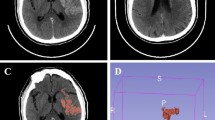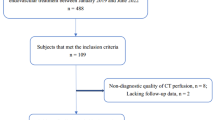Abstract
Purpose
The objective of this study was to evaluate the relationship between arterial transit artifact (ATA), arterial spin labeling (ASL) perfusion imaging, and the outcome of patients with acute ischemic stroke (AIS) due to occlusion of large vessels in anterior circulation after endovascular thrombectomy (EVT).
Methods
Patients with anterior circulation occlusion treated with EVT between October 2017 and December 2021 were enrolled in this retrospective study, and ATA was quantified by a 4-point scale. A favorable outcome was defined by modified Rankin Scale (mRS) scores of 0–2 at 3 months. To identify independent predictors of favorable outcome, age, sex, risk factors, baseline National Institutes of Health Stroke Scale (NIHSS) score, site of occlusion, cause of stroke, and early reperfusion were evaluated with univariate and multivariate analyses. Predictive accuracy was evaluated by calculating the area under the receiver operating characteristic (ROC) curve (AUC) for the model.
Results
In this study 187 patients (age, 65.0 ± 12.5 years; men, 55%) were evaluated. Younger age (odds ratio, OR, 0.95; 95% confidence interval, CI, 0.92–0.98, p = 0.002), lower baseline NIHSS score (OR, 0.88; 95% CI, 0.82–0.94, p < 0.001), and lower ATA score (OR, 1.14; 95% CI, 1.06–1.22, p < 0.001) were independently associated with favorable outcomes in multivariate analysis. The ATA score has moderate to good accuracy in predicting favorable outcomes (AUC, 0.753).
Conclusion
A high ATA score as a potential predictor, can help identify patients who may benefit from EVT.



Similar content being viewed by others
Abbreviations
- AIS:
-
Acute ischemic stroke
- ASL:
-
Arterial spin labeling
- ASPECTS:
-
Alberta Stroke Program Early CT Score
- ATA:
-
Arterial transit artifact
- ATT:
-
Arterial transit time
- AUC:
-
Area under the curve
- CTA:
-
Computerized tomography angiography
- DSA:
-
Digital subtraction angiography
- DWI:
-
Diffusion-weighted imaging
- EVT:
-
Endovascular thrombectomy
- FLAIR:
-
Fluid-attenuated inversion recovery
- ICAS‑O:
-
Intracranial atherosclerosis-related occlusion
- mRS:
-
Modified Rankin Scale
- mTICI:
-
Modified treatment in cerebral infarction
- NIHSS:
-
National Institutes of Health Stroke Scale
- PLD:
-
Postlabeling delay
- ROC:
-
Receiver operating characteristic
- TIA:
-
Transient ischemic attack
- tPA:
-
Tissue plasminogen activator
References
Goyal M, Demchuk AM, Menon BK, et al. Randomized assessment of rapid endovascular treatment of ischemic stroke. N Engl J Med. 2015;372:1019–30.
Campbell BCV, Mitchell PJ, Kleinig TJ, et al. Endovascular therapy for ischemic stroke with perfusion-imaging selection. N Engl J Med. 2015;372:1009–18.
Berkhemer OA, Fransen PSS, Beumer D, et al. A randomized trial of intraarterial treatment for acute ischemic stroke. N Engl J Med. 2015;372:11–20.
Goyal M, Menon BK, van Zwam WH, et al. Endovascular thrombectomy after large-vessel ischaemic stroke: a meta-analysis of individual patient data from five randomised trials. Lancet. 2016;387:1723–31.
Bonney PA, Walcott BP, Singh P, Nguyen PL, Sanossian N, Mack WJ. The Continued Role and Value of Imaging for Acute Ischemic Stroke. Neurosurgery. 2019;85:S23–S30.
de Havenon A, Haynor DR, Tirschwell DL, et al. Association of Collateral Blood Vessels Detected by Arterial Spin Labeling Magnetic Resonance Imaging With Neurological Outcome After Ischemic Stroke. JAMA Neurol. 2017;74:453–8.
Zaharchuk G, Do HM, Marks MP, Rosenberg J, Moseley ME, Steinberg GK. Arterial spin-labeling MRI can identify the presence and intensity of collateral perfusion in patients with moyamoya disease. Stroke. 2011;42:2485–91.
Zaidat OO, Yoo AJ, Khatri P, et al. Recommendations on angiographic revascularization grading standards for acute ischemic stroke: a consensus statement. Stroke. 2013;44:2650–63.
Barreto AD, Fanale CV, Alexandrov AV, et al. Prospective, open-label safety study of intravenous recombinant tissue plasminogen activator in wake-up stroke. Ann Neurol. 2016;80:211–8.
Hartkamp NS, van Osch MJP, Kappelle J, Bokkers RPH. Arterial spin labeling magnetic resonance perfusion imaging in cerebral ischemia. Curr Opin Neurol. 2014;27:42–53.
Taso M, Aramendía-Vidaurreta V, Englund EK, et al. Update on state-of-the-art for arterial spin labeling (ASL) human perfusion imaging outside of the brain. Magn Reson Med. 2023;89:1754–76.
Zaharchuk G. Arterial spin-labeled perfusion imaging in acute ischemic stroke. Stroke. 2014;45:1202–7.
Bang OY, Goyal M, Liebeskind DS. Collateral Circulation in Ischemic Stroke: Assessment Tools and Therapeutic Strategies. Stroke. 2015;46:3302–9.
Di Napoli A, Cheng SF, Gregson J, et al. Arterial Spin Labeling MRI in Carotid Stenosis: Arterial Transit Artifacts May Predict Symptoms. Radiology. 2020;297:652–60.
Nam KW, Kim CK, Ko SB, Yoon BW, Yoo RE, Sohn CH. Regional Arterial Spin Labeling Perfusion Defect Is Associated With Early Ischemic Recurrence in Patients With a Transient Ischemic Attack. Stroke. 2020;51:186–92.
Ginsberg MD. The cerebral collateral circulation: Relevance to pathophysiology and treatment of stroke. Neuropharmacology. 2018;134:280–92.
Parsons MW, Albers GW. MR RESCUE: is the glass half-full or half-empty? Stroke. 2013;44:2055–7.
Fanou EM, Knight J, Aviv RI, et al. Effect of Collaterals on Clinical Presentation, Baseline Imaging, Complications, and Outcome in Acute Stroke. AJNR Am J Neuroradiol. 2015;36:2285–91.
Sundaram S, Kannoth S, Thomas B, Sarma PS, Sylaja PN. Collateral Assessment by CT Angiography as a Predictor of Outcome in Symptomatic Cervical Internal Carotid Artery Occlusion. AJNR Am J Neuroradiol. 2017;38:52–7.
Sallustio F, Motta C, Pizzuto S, et al. CT angiography-based collateral flow and time to reperfusion are strong predictors of outcome in endovascular treatment of patients with stroke. J Neurointerv Surg. 2017;9:940–3.
Leng X, Fang H, Leung TW, et al. Impact of collaterals on the efficacy and safety of endovascular treatment in acute ischaemic stroke: a systematic review and meta-analysis. J Neurol Neurosurg Psychiatry. 2016;87:537–44.
Thomalla G, Simonsen CZ, Boutitie F, et al. MRI-Guided Thrombolysis for Stroke with Unknown Time of Onset. N Engl J Med. 2018;379:611–22.
Kishi F, Nakagawa I, Park H, et al. Low relative diffusion weighted image signal intensity can predict good prognosis after endovascular thrombectomy in patients with acute ischemic stroke. J Neurointerv Surg. 2022;14:618–22.
Sheth SA, Liebeskind DS. Collaterals in endovascular therapy for stroke. Curr Opin Neurol. 2015;28:10–5.
Menon BK, Qazi E, Nambiar V, et al. Differential Effect of Baseline Computed Tomographic Angiography Collaterals on Clinical Outcome in Patients Enrolled in the Interventional Management of Stroke III Trial. Stroke. 2015;46:1239–44.
Menon BK, O’Brien B, Bivard A, et al. Assessment of leptomeningeal collaterals using dynamic CT angiography in patients with acute ischemic stroke. J Cereb Blood Flow Metab. 2013;33:365–71.
Menon BK, Smith EE, Modi J, et al. Regional leptomeningeal score on CT angiography predicts clinical and imaging outcomes in patients with acute anterior circulation occlusions. AJNR Am J Neuroradiol. 2011;32:1640–5.
Christoforidis GA, Mohammad Y, Kehagias D, Avutu B, Slivka AP. Angiographic assessment of pial collaterals as a prognostic indicator following intra-arterial thrombolysis for acute ischemic stroke. AJNR Am J Neuroradiol. 2005;26:1789–97.
Higashida RT, Furlan AJ, Roberts H, et al. Trial design and reporting standards for intra-arterial cerebral thrombolysis for acute ischemic stroke. Stroke. 2003;34:e109–e37.
Rebello LC, Bouslama M, Haussen DC, et al. Stroke etiology and collaterals: atheroembolic strokes have greater collateral recruitment than cardioembolic strokes. Eur J Neurol. 2017;24:762–7.
Zhang X, Zhang M, Ding W, Yan S, Liebeskind DS, Lou M. Distinct predictive role of collateral status on clinical outcome in variant stroke subtypes of acute large arterial occlusion. Eur J Neurol. 2018;25:293–300.
Guglielmi V, LeCouffe NE, Zinkstok SM, et al. Collateral Circulation and Outcome in Atherosclerotic Versus Cardioembolic Cerebral Large Vessel Occlusion. Stroke. 2019;50:3360–8.
Heit JJ, Mlynash M, Christensen S, et al. What predicts poor outcome after successful thrombectomy in late time windows? J NeuroIntervent Surg. 2021;13:421–5.
Ghozy S, Kacimi SEO, Azzam AY, et al. Successful mechanical thrombectomy in acute ischemic stroke: revascularization grade and functional independence. J NeuroIntervent Surg. 2022;14:779–82.
Acknowledgements
The authors thank AiMi Academic Services (www.aimieditor.com) for English language editing and review services.
Funding
This study was supported by Xi’an Science and Technology Planning Project (21YXYJ0004), Natural Science Basic Research Project of Shaanxi Province (2022JM-452).
Author information
Authors and Affiliations
Corresponding authors
Ethics declarations
Conflict of interest
X. Zhang, N. Han, Y. Zhang, W. Yuan, S. Kan, G. Zhang, H. Ma, H. Ge, C. Du, Y. Gao, S. Li, X. Yan, W. Shi, Y. Tian and M. Chang declare that they have no competing interests.
Ethical standards
Ethics approval: the Institutional Review Board of the Affiliated Hospital of Northwest University approved this study (No. SYXSLL-2018-010), and the requirement for informed patient consent was waived due to the study’s retrospective nature. Informed consent: this was a retrospective study, hence, no informed consent is needed.
Additional information
Publisher’s Note
Springer Nature remains neutral with regard to jurisdictional claims in published maps and institutional affiliations.
Ye Tian and Mingze Chang contributed equally to this work.
Xiaobo Zhang and Nannan Han are co-first authors.
Rights and permissions
Springer Nature or its licensor (e.g. a society or other partner) holds exclusive rights to this article under a publishing agreement with the author(s) or other rightsholder(s); author self-archiving of the accepted manuscript version of this article is solely governed by the terms of such publishing agreement and applicable law.
About this article
Cite this article
Zhang, X., Han, N., Zhang, Y. et al. Predicting 3-month Functional Outcome After Endovascular Thrombectomy in Patients with Anterior Circulation Occlusion with an Arterial Transit Artifact Grading System. Clin Neuroradiol 34, 241–249 (2024). https://doi.org/10.1007/s00062-023-01362-3
Received:
Accepted:
Published:
Issue Date:
DOI: https://doi.org/10.1007/s00062-023-01362-3




